Transformer Operation and Shutdown Under Specific Conditions: When Should You Pull the Plug?
Have you ever wondered when it’s time to shut down a transformer? The answer could mean the difference between a minor inconvenience and a major catastrophe.
Transformer operation and shutdown under specific conditions are critical for maintaining safety and equipment integrity. Key factors include overheating, electrical faults, oil leaks, and abnormal noise or vibration. Proper monitoring and quick decision-making are essential to prevent severe damage or accidents.
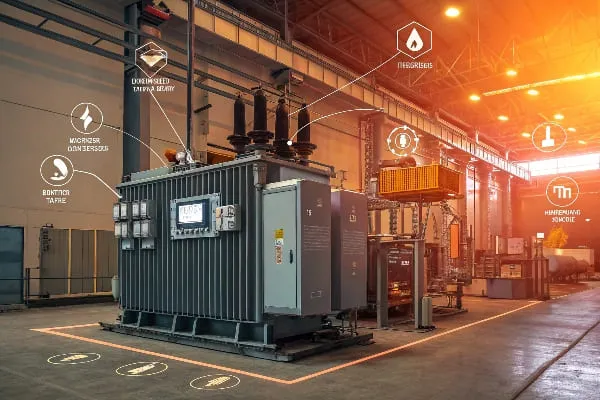
In my years of working with transformers, I’ve learned that knowing when to shut down is as important as knowing how to operate. Let’s dive into the specifics of transformer operation and shutdown to keep your power systems safe and efficient.
Conditions Leading to Transformer Shutdown: When Is Enough Enough?
Have you ever faced that heart-stopping moment when you realize your transformer might be on the brink of failure? Knowing when to shut it down can save you from disaster.
Transformer shutdown is necessary under conditions such as severe overheating, internal faults, significant oil leaks, or extreme environmental events. These situations pose immediate risks to the transformer’s integrity and overall system safety.
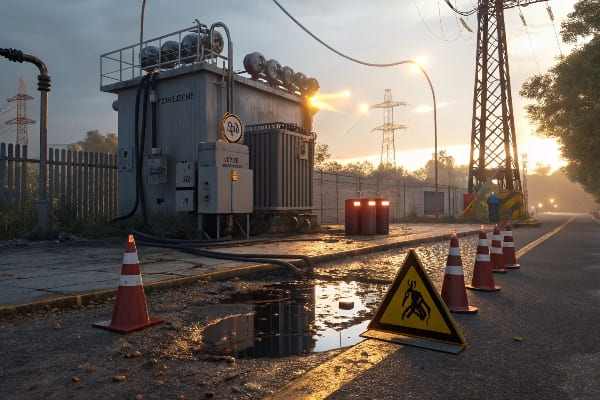
Throughout my career, I’ve encountered various scenarios that necessitated immediate transformer shutdown. Here’s what you need to know:
Critical Shutdown Conditions
-
Overheating:
- Excessive temperature rise in windings or oil
- Can lead to insulation breakdown and potential fire
-
Electrical Faults:
- Internal short circuits or ground faults
- Risk of explosive failure if not addressed immediately
-
Oil-Related Issues:
- Significant oil leaks or low oil levels
- Compromises cooling and insulation integrity
Environmental Triggers
| Condition | Risk | Action |
|---|---|---|
| Flooding | Water ingress, electrical hazards | Immediate shutdown and isolation |
| Severe storms | Lightning strikes, physical damage | Preemptive shutdown if severe warning |
| Earthquakes | Structural damage, oil spills | Shutdown and thorough inspection |
Operational Anomalies
Based on my experience, these operational signs often indicate the need for shutdown:
-
Abnormal Noise:
- Sudden loud buzzing or humming
- May indicate severe internal issues
-
Excessive Vibration:
- Can signify loose windings or core problems
- Risk of mechanical failure if left unchecked
-
Rapid Pressure Rise:
- Indicated by sudden Buchholz relay trips
- Often a sign of internal arcing or gas generation
I once encountered a situation where a transformer was making an unusual humming noise. Despite pressure from management to keep it running, I insisted on a shutdown. Upon inspection, we found that several of the core laminations had come loose, risking a catastrophic failure. This experience reinforced my belief in always erring on the side of caution when it comes to transformer safety.
Remember, the decision to shut down a transformer should never be taken lightly, but hesitation in critical situations can lead to far worse consequences. It’s always better to have a temporary outage than to risk a long-term disaster.
Impact of Abnormal Operating Conditions on Transformer Performance: What’s Really at Stake?
Ever wondered why some transformers seem to age faster than others? The secret often lies in how they’re operated under abnormal conditions. Let’s uncover the hidden costs of pushing your transformer to its limits.
Abnormal operating conditions can significantly impact transformer performance, leading to reduced efficiency, accelerated aging, and increased risk of failure. Overloading, harmonics, and voltage fluctuations are key factors that can compromise transformer integrity and lifespan.
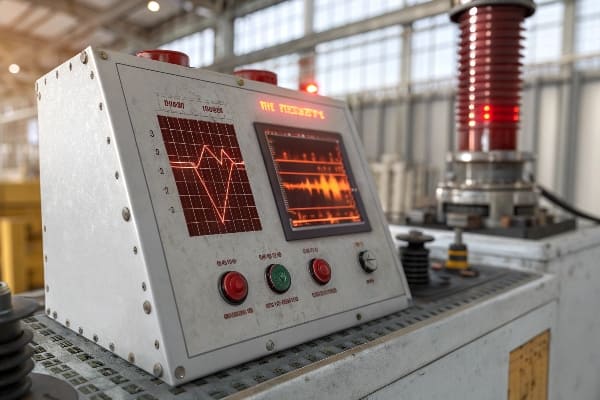
In my years of experience, I’ve seen how abnormal conditions can turn a reliable transformer into a ticking time bomb. Here’s what you need to know:
Key Abnormal Operating Conditions
-
Overloading:
- Exceeds designed capacity, causing excessive heating
- Accelerates insulation degradation
-
Harmonic Distortion:
- Non-linear loads introduce harmonics
- Increases losses and causes localized heating
-
Voltage Fluctuations:
- Overvoltage or undervoltage conditions
- Stresses insulation and affects core performance
Performance Impacts
| Condition | Short-Term Impact | Long-Term Consequence |
|---|---|---|
| Overloading | Increased temperature, higher losses | Reduced lifespan, potential failure |
| Harmonics | Increased eddy currents, hot spots | Insulation breakdown, increased maintenance |
| Voltage Fluctuations | Increased magnetizing current, core saturation | Accelerated aging, reduced efficiency |
Efficiency and Lifespan Considerations
Based on my observations, here’s how abnormal conditions affect transformer performance:
-
Efficiency Reduction:
- Overloading increases copper losses
- Harmonics increase core losses
- Overall efficiency can drop by 1-2% under sustained abnormal conditions
-
Accelerated Aging:
- Normal transformer life expectancy is 20-30 years
- Continuous operation under abnormal conditions can halve this lifespan
-
Increased Maintenance Needs:
- More frequent oil changes and treatments
- Higher risk of unexpected failures requiring emergency maintenance
I once worked with a manufacturing plant that consistently overloaded their transformer during peak production hours. Over just three years, we observed a 20% decrease in the transformer’s expected lifespan. By implementing load management strategies and installing harmonic filters, we were able to extend the transformer’s life and improve its overall performance.
Hidden Costs of Abnormal Operation
-
Energy Losses:
- Increased losses mean higher energy bills
- Can add up to significant costs over time
-
Reliability Issues:
- Higher risk of unexpected outages
- Can lead to production losses in industrial settings
-
Environmental Impact:
- Increased energy consumption leads to higher carbon footprint
- Risk of oil leaks or fires in case of severe failure
Remember, while transformers are designed to handle some level of abnormal operation, consistent exposure to these conditions will inevitably take its toll. Proper monitoring, timely intervention, and adherence to operating guidelines are key to maintaining transformer performance and longevity.
Monitoring and Detection of Critical Operating Conditions: How to Stay Ahead of the Curve?
Ever felt like you’re always one step behind your transformer’s problems? It’s time to turn the tables and get ahead of potential issues before they become critical.
Effective monitoring and detection of critical operating conditions in transformers involve a combination of real-time sensors, regular testing, and advanced diagnostic techniques. Key parameters to monitor include temperature, oil condition, electrical characteristics, and gas composition.

Throughout my career, I’ve seen how proper monitoring can be the difference between a minor adjustment and a major overhaul. Here’s how to stay vigilant:
Essential Monitoring Parameters
-
Temperature Monitoring:
- Winding temperature indicators
- Top oil temperature sensors
- Hotspot temperature calculation
-
Oil Condition Monitoring:
- Moisture content sensors
- Oil level indicators
- Partial discharge detection
-
Electrical Parameter Monitoring:
- Load current measurement
- Voltage regulation tracking
- Power factor monitoring
Advanced Detection Techniques
| Technique | What It Detects | Frequency |
|---|---|---|
| Dissolved Gas Analysis (DGA) | Internal faults, oil breakdown | Monthly or continuous |
| Frequency Response Analysis (FRA) | Winding deformation, core issues | Annually or after events |
| Partial Discharge Monitoring | Insulation weaknesses | Continuous or periodic |
Real-Time Monitoring Systems
Based on my experience, implementing a comprehensive real-time monitoring system can provide invaluable insights:
-
SCADA Integration:
- Allows for remote monitoring and control
- Enables trend analysis and predictive maintenance
-
Online DGA Monitors:
- Continuous monitoring of key fault gases
- Early detection of developing faults
-
Fiber Optic Sensors:
- Direct measurement of winding temperatures
- High accuracy and fast response times
I once worked on a project where we installed a comprehensive online monitoring system on a critical substation transformer. Within the first month, the system detected a slight increase in acetylene levels, indicating a developing arc inside the transformer. We were able to schedule a controlled outage and repair the issue before it led to a catastrophic failure. This early intervention saved the utility millions in potential damages and outage costs.
Interpretation and Action
-
Alarm Systems:
- Set up multi-level alarms for different severity levels
- Ensure clear protocols for each alarm type
-
Trend Analysis:
- Regularly review historical data
- Look for subtle changes that might indicate developing issues
-
Predictive Maintenance:
- Use AI and machine learning algorithms to predict potential failures
- Schedule maintenance based on actual condition rather than fixed intervals
Remember, effective monitoring is not just about collecting data – it’s about interpreting that data and taking timely action. By implementing a robust monitoring and detection system, you can catch potential issues early, extend your transformer’s life, and avoid costly unplanned outages.
Safety Protocols for Transformer Shutdown: How to Power Down Without the Meltdown?
Ever wondered what it takes to shut down a transformer safely? It’s not just about flipping a switch – it’s a carefully choreographed process that can mean the difference between a smooth power-down and a potential disaster.
Safety protocols for transformer shutdown involve a systematic approach to de-energizing, isolating, and securing the equipment. Key steps include load transfer, circuit breaker operation, grounding, and lockout/tagout procedures. Proper execution of these protocols is crucial for personnel safety and equipment protection.
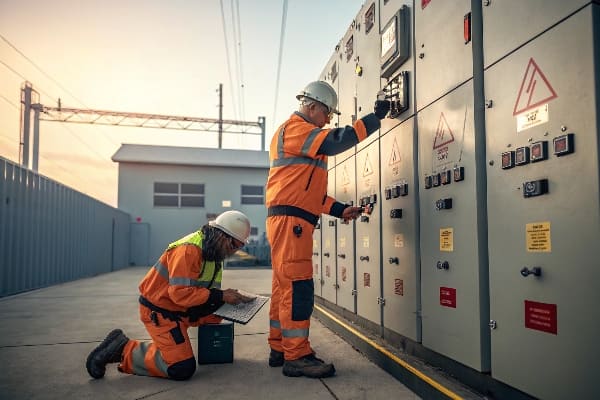
In my years of working with transformers, I’ve learned that a well-executed shutdown is as important as proper operation. Here’s how to do it right:
Step-by-Step Shutdown Procedure
-
Pre-Shutdown Assessment:
- Evaluate the reason for shutdown
- Plan for load transfer or power interruption
-
Load Transfer:
- Gradually reduce load on the transformer
- Transfer critical loads to alternate sources if possible
-
De-energization:
- Open the main circuit breaker
- Confirm power cut-off on all sides
Isolation and Grounding
| Step | Action | Purpose |
|---|---|---|
| Open Disconnects | Isolate transformer from all sources | Ensure complete isolation |
| Apply Grounds | Connect portable ground cables | Protect against residual charge and accidental re-energization |
| Verify Isolation | Use voltage detectors | Confirm absence of voltage |
Lockout/Tagout Procedures
Based on my experience, strict adherence to lockout/tagout procedures is non-negotiable:
-
Lockout:
- Apply locks to all isolation points
- Each worker should apply their personal lock
-
Tagout:
- Attach clear, informative tags to locked devices
- Include reason for shutdown, date, and responsible person
-
Verification:
- Double-check all lockouts and tags
- Conduct a team briefing to ensure everyone understands the scope of work
I once witnessed a near-miss incident where a maintenance team started work on a transformer that wasn’t properly isolated. Thanks to a last-minute catch during our safety check, we avoided what could have been a fatal accident. This experience reinforced the critical importance of following shutdown protocols to the letter.
Additional Safety Measures
-
Ventilation:
- Ensure proper ventilation if entering confined spaces
- Test for hazardous gases before entry
-
Oil Handling:
- Prepare for potential oil leaks or spills
- Have absorbent materials and containment equipment ready
-
Communication:
- Notify all relevant parties of the shutdown
- Establish clear communication channels for the duration of the work
Remember, a safe shutdown is the foundation for all subsequent maintenance or repair work. By following these protocols diligently, you not only protect your personnel but also set the stage for efficient and effective transformer work.
Consequences of Delayed Shutdown in Adverse Conditions: What’s the Worst That Could Happen?
Have you ever been tempted to keep a transformer running just a little longer, despite warning signs? The consequences of such decisions can be dire. Let’s explore what’s really at stake when you delay shutting down a transformer in adverse conditions.
Delayed shutdown in adverse conditions can lead to catastrophic transformer failure, posing severe safety risks and causing extensive damage. Consequences may include explosive failure, fire, environmental contamination, and prolonged power outages. The financial and safety implications of delayed action can far outweigh the perceived benefits of continued operation.
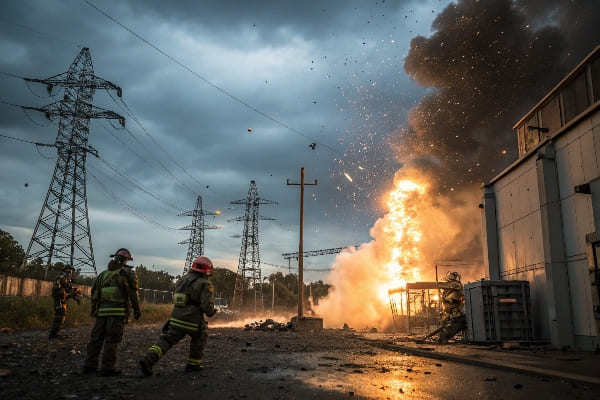
Throughout my career, I’ve seen the aftermath of delayed shutdowns, and the results are often sobering. Here’s what you need to know:
Immediate Risks of Delayed Shutdown
-
Catastrophic Failure:
- Internal faults can escalate rapidly
- Risk of explosive failure increases with time
-
Fire Hazard:
- Overheating can lead to oil ignition
- Electrical arcing can cause fires
-
Environmental Impact:
- Oil spills can contaminate soil and water
- Smoke from fires can release toxic substances
Long-Term Consequences
| Consequence | Impact | Recovery Time |
|---|---|---|
| Equipment Damage | Total loss of transformer | Months for replacement |
| System Instability | Cascading failures in the grid | Hours to days |
| Reputational Damage | Loss of customer trust | Years to rebuild |
Case Studies from My Experience
I’ve encountered several situations that highlight the dangers of delayed shutdown:
-
The Overloaded Substation:
- Transformer showed signs of overheating
- Decision to continue operation during peak demand
- Result: Catastrophic failure, 3-day outage for thousands of customers
-
The Ignored Oil Leak:
- Small oil leak detected but deemed "minor"
- Continued operation led to major leak
- Result: Environmental cleanup costs exceeded $1 million
-
The Persistent Partial Discharge:
- Partial discharge detected but not immediately addressed
- Insulation breakdown accelerated rapidly
- Result: Explosive failure, narrowly avoiding injuries
Hidden Costs of Delayed Action
-
Increased Repair Costs:
- Minor issues can escalate into major repairs
- Complete replacement often necessary after severe failures
-
Extended Downtime:
- Catastrophic failures lead to longer outages
- Replacement transformers may have long lead times
-
Legal and Regulatory Consequences:
- Potential fines for environmental violations
- Liability issues if failures lead to injuries or property damage
Remember, the decision to delay a shutdown is often driven by short-term thinking – avoiding a brief outage or meeting immediate demand. However, the potential consequences of this decision can far outweigh any temporary benefits. In my experience, it’s always better to err on the side of caution when it comes to transformer operation in adverse conditions.
Best Practices for Restarting Transformers After Shutdown: How to Power Up Safely?
Ever felt the pressure to get a transformer back online quickly after a shutdown? While speed is important, safety and proper procedures are paramount. Let’s explore how to restart your transformer the right way.
Restarting transformers after shutdown requires a systematic approach to ensure safety and prevent equipment damage. Key steps include thorough inspections, proper re-energization procedures, and careful monitoring during startup. Following best practices is crucial for avoiding issues like inrush currents and potential failures.
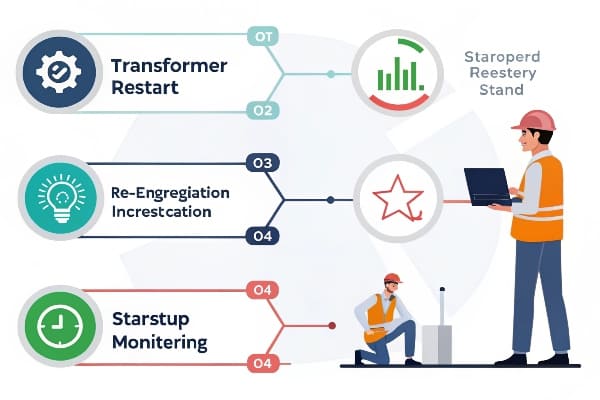
In my years of experience, I’ve learned that a careful restart can prevent a host of problems down the line. Here’s how to do it right:
Pre-Restart Inspection Checklist
-
Visual Inspection:
- Check for any physical damage or leaks
- Ensure all temporary grounds are removed
-
Electrical Tests:
- Conduct insulation resistance tests
- Verify transformer turns ratio
-
Oil Tests:
- Check oil levels and top up if necessary
- Perform dielectric strength test if shutdown was prolonged
Step-by-Step Restart Procedure
| Step | Action | Purpose |
|---|---|---|
| 1. Remove Lockouts | Systematically remove all locks and tags | Prepare for re-energization |
| 2. Close Disconnects | Re-establish electrical connections | Ready the transformer for power |
| 3. Energize Slowly | Use reduced voltage if possible | Minimize inrush current |
| 4. Monitor Closely | Watch for abnormal sounds or readings | Detect any issues immediately |
Managing Inrush Current
Based on my experience, managing inrush current is crucial during restart:
-
Point-on-Wave Switching:
- Use controlled switching devices
- Energize at optimal point of voltage wave
-
Staged Energization:
- For large transformers, energize in stages
- Start with low voltage winding if possible
-
Monitoring Inrush:
- Use current transformers to monitor inrush
- Be prepared to trip if inrush exceeds expected levels
I once worked on restarting a critical substation transformer after an emergency shutdown. We used point-on-wave switching and carefully monitored the inrush current. This careful approach prevented potential issues and allowed for a smooth restart, avoiding any damage to the transformer or disruption to the grid.
Post-Restart Monitoring
-
Temperature Monitoring:
- Watch for abnormal temperature rises
- Ensure cooling systems are functioning properly
-
Load Management:
- Gradually increase load to full capacity
- Monitor for any unusual heating or vibration
-
Gas Monitoring:
- If equipped, check dissolved gas levels
- Look for any sudden increases in key gases
Documentation and Reporting
-
Restart Log:
- Record all steps taken during the restart process
- Note any unusual observations or readings
-
Performance Tracking:
- Monitor transformer performance closely for the first 24 hours
- Compare with pre-shutdown benchmarks
-
Lessons Learned:
- Conduct a post-restart review
- Identify any areas for improvement in the restart procedure
Remember, a successful restart is not just about getting the transformer back online – it’s about ensuring its continued reliable operation. Taking the time to follow these best practices can save you from potential headaches and costly failures down the line.
Conclusion
Proper transformer operation, timely shutdown, and careful restart procedures are crucial for maintaining safety, reliability, and longevity of power systems. By understanding critical conditions, following safety protocols, and implementing best practices, we can ensure optimal transformer performance and prevent costly failures.
Free CHBEB Transformer Catalog Download
Get the full range of CHBEB transformers in one catalog.
Includes oil-immersed, dry-type, pad-mounted, and custom solutions.
Quick Message
Request A free quote
We'd like to work with you
- +86 15558785111
- [email protected]
- +86 15558785111
What We Do
CHINA BEI ER BIAN (CHBEB) GROUP, with 218 million in registered capital, originated from Beijing Beierbian Transformer Group. Headquartered in Beijing for R&D, it operates major production bases in Nanjing and Yueqing, producing high-quality products.
Latest Product
address
BeiJing
No 3,RongJing East Road,BeiJing Economic Technological Development Area,BeiJing,China
JiangSu
No 7️Xiangfeng Road,Jiangning,NanJing,JiangSu,China
WenZhou
No.211, Wei 16 Road, Industrial Zone, Yueqing, Wenzhou, Zhejiang, China.
XiangYang Industrial Zone ,YueQing,WenZhou,ZheJiang,China
contact us
- [email protected]
- +86 13057780111
- +86 13057780111
- +86 15558785111
Copyright © Bei Er Bian Group


